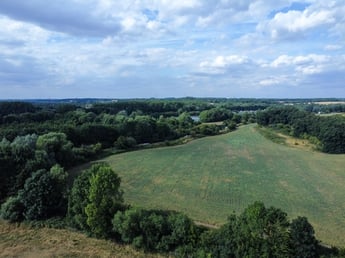What is natural capital?
Natural capital is any natural asset that brings value to people. Examples include biodiversity, air, soil, water, trees or assets with societal benefits, such as historic land.
For a detailed description, see our blog: Natural Capital - what is it and how can it be measured on farmland?
The concept of natural capital encourages farmers to attach financial value to the natural assets found on farmland, protecting and regenerating them for public or financial gain. Beyond the wider benefits to the environment and society, investing in natural capital can support farm business resilience and help increase efficiency.
Woodland management
Woodland management is a great starting point for natural capital as most farms contain hedgerows and trees.
Woodland has the potential to filter and store greenhouse gas gases, support ecosystems and provide recreational benefits for people.
Maintaining existing woodland or establishing new hedgerows and trees can make use of low-grade agricultural land or improve areas prone to flooding.
Planting new trees can be used to generate carbon credits, which can be traded through government-backed or private markets. Examples include the Woodland Carbon Guarantee auctions (via the Woodland Carbon Code) and the England Woodland Creation Offer.
However, woodland management needs careful planning; it is important to plant the right tree in the right place to avoid introducing pests and disease, or negatively affecting existing habitats.
Water resource management
Managing water sources is another proactive way to boost natural capital on farms and estates.
Introducing sustainable drainage systems – such as buffer strips, ponds and silt traps – protects against flooding and shields water sources from pollutants, while providing habitats.
Optimising nitrogen use can also help protect water courses from agricultural run-off and reduce fertiliser costs. To support with this, water companies have been paying farmers to invest in sustainable land use techniques to limit the need for removing pollutants from water courses.
Planting physical barriers can also contribute to the Campaign for the Farmed Environment or Natural England’s Environmental Stewardship Scheme.
Improving soil health
Looking after your soil is integral for crop production and healthy pastures. And like woodland, soil is recognised for its carbon storage properties.
Some farmers are moving to sustainable land management techniques or regenerative practices that do not disturb the soil, such as minimum or no-till and direct drilling. This reduces their carbon footprint and improves soil structure.
Boosting biodiversity, supporting pollinators
If you have margins of land connecting fields, unused corners or plots, it could be beneficial to designate them for wildflowers. Wildflower areas create habitats for insects that pollinate crops or contribute to integrated pest management.
Aligning wildflower margins with hedges and ditches can also add to water protection and allow animals to move around the landscape. Wildflower meadows may also provide additional opportunities to sell biodiversity credits to developers.
How LAND360 can help
LAND360 helps farmers to understand what natural assets they have, providing a sound evidence base to aid decision-making for sustainable land use and future revenue.
What is LAND360?